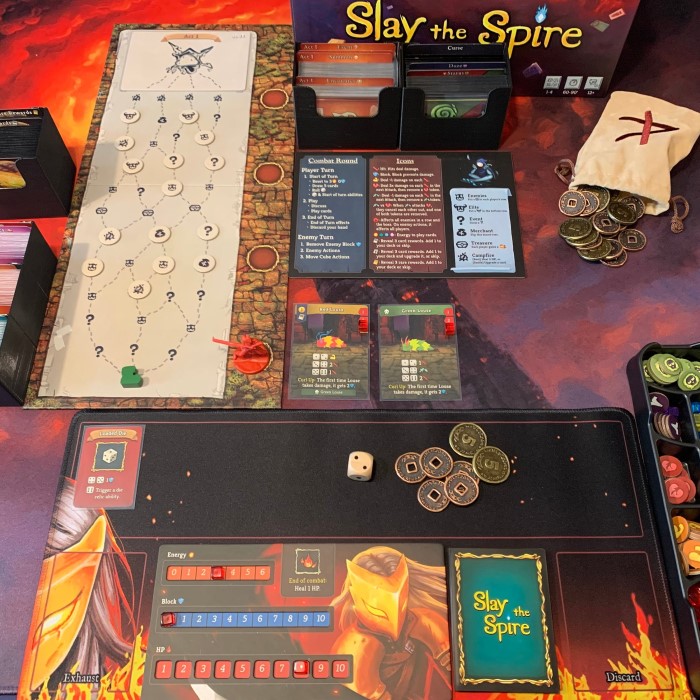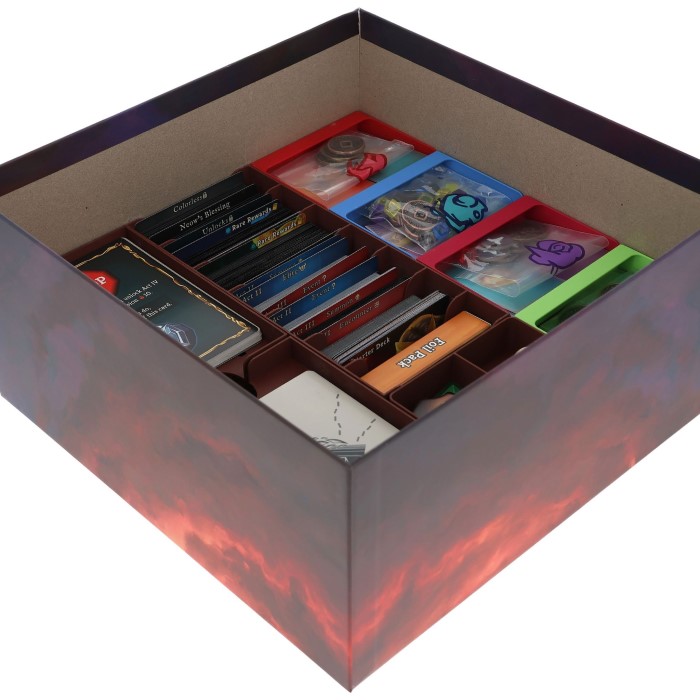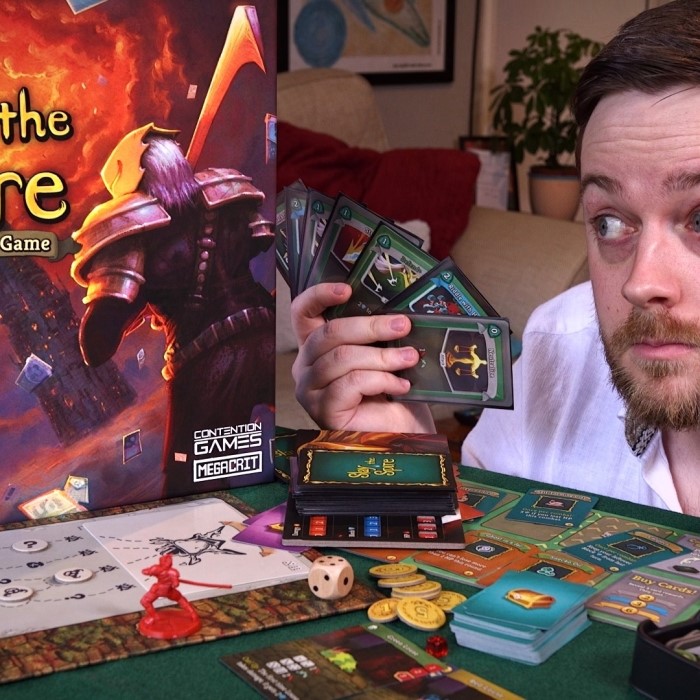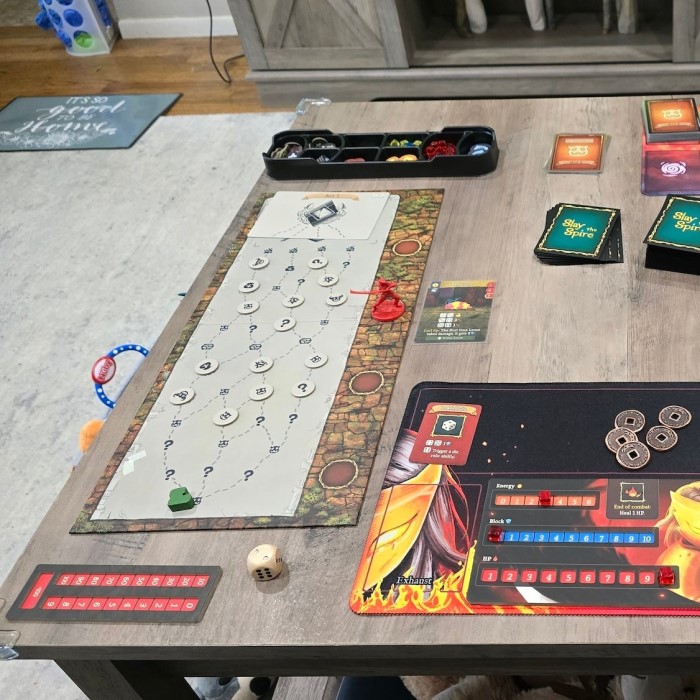Introduction
The Slay the Spire board game is a tabletop adaptation of the popular video game. It brings the iconic deckbuilding mechanics and dungeon-crawling challenges to a physical format. Players can enjoy strategic gameplay while gathering relics, crafting personalized decks, and defeating enemies. Whether solo or with friends, the board game offers engaging sessions full of strategy and fun.
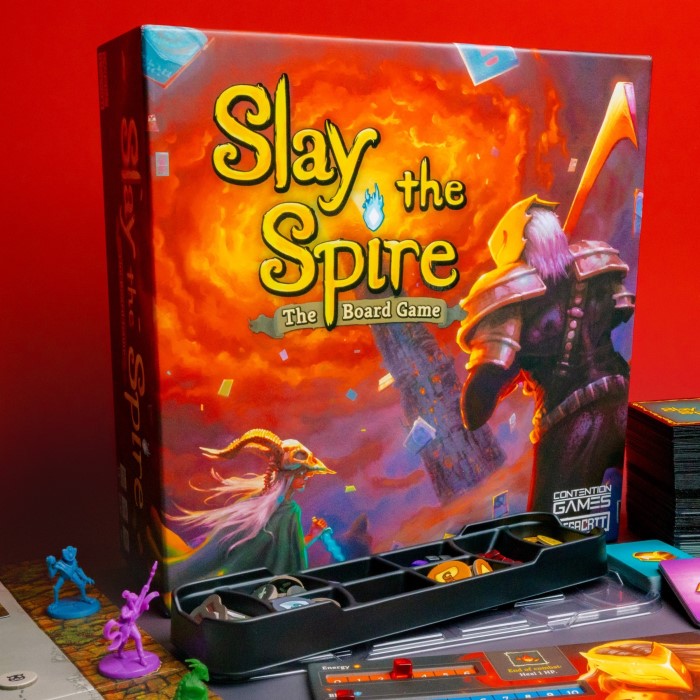
Origins and Inspiration from the Video Game
The board game is inspired by the award-winning digital roguelike, Slay the Spire. It captures the essence of its source material, including challenging battles, deck customization, and relics. The creators aimed to translate the video game’s unique mechanics into a tangible gaming experience. Fans of the digital version will recognize its blend of strategic planning and unpredictable encounters.
What Makes It Unique Compared to Other Board Games
Slay the Spire stands out due to its dynamic deckbuilding feature. This mechanic evolves throughout the game as players choose new cards, improving their strategies. The mix of roguelike unpredictability, cooperative modes, and solo campaigns sets it apart from traditional board games. Additionally, its design ensures every playthrough feels fresh, challenging, and rewarding.
Gameplay Mechanics
The Slay the Spire board game captures the essence of its digital counterpart. Gameplay revolves around strategic deckbuilding, battling enemies, and gathering powerful relics. It’s designed to challenge players with dynamic choices and unpredictable events, creating an engaging experience.
Core Features of Slay the Spire Board Game
- Dynamic Deckbuilding Mechanics: Players craft decks by acquiring new cards as the game progresses. Each card adds abilities or strategies to overcome challenges.
- Roguelike Elements: The game incorporates randomness, ensuring every session feels fresh and different.
- Relics and Rewards: Relics offer powerful enhancements that can turn the tide in battles. Choosing the right relics is key.
- Progressive Gameplay: Navigate through the board while defeating enemies, upgrading cards, and facing bosses for ultimate victory.
- Scalable Difficulty: Customize the level of challenge based on your gaming preferences and experience.
Understanding Cards, Relics, and Deckbuilding
Cards: Cards are central to the gameplay as they drive combat and tactical choices. Players must strategically select cards that complement their objectives and character playstyles.
Relics: Relics provide passive boosts during the game. From increasing attack power to offering defensive perks, selecting relics is a critical part of crafting a winning strategy.
Deckbuilding: The deck evolves throughout the game. Unlike static setups, players adapt their deck with new cards and upgrades to strengthen their chances of survival. The choices you make define your strategy and the overall outcome.
Cooperative vs. Solo Game Modes
The board game caters to different gaming preferences with its versatile modes:
Solo Mode: Solo mode lets you experience the challenges independently. It focuses on personal strategy and survival, making each decision more impactful.
Cooperative Mode: Cooperative play allows friends to team up against the game’s challenges. Work together to battle enemies, share insights, and build complementary strategies. This mode encourages communication and teamwork, enriching social play.
Whether playing solo or in groups, the game’s flexible modes ensure everyone enjoys the adventure.
Characters and Playstyles
Key Playable Characters and Their Roles
The Slay the Spire board game features key characters with unique abilities and playstyles. Each character brings distinct strengths, weaknesses, and strategies to the table. Understanding their roles is critical to success in the game.
- The Ironclad: A strong warrior specializing in offense and defense. Focus on powerful attacks and sustainability.
- The Silent: A sly assassin excelling in agility and deception. Utilize poisons and swift strikes for damage.
- The Defect: A mysterious robot leveraging orbs for elemental attacks and defenses. Adaptability is its core strength.
- The Watcher: A mystical master of stances. Use calm and wrath stances for balanced yet explosive strategies.
Selecting the right character can shape your playthrough. The choice impacts how you approach battles and build your deck.
Customizing Your Strategy with Different Decks
Deck customization is a key feature of Slay the Spire. Each character starts with a basic deck. You enhance this deck by acquiring new cards and relics as the game progresses.
- Tailor to Strengths: Build decks that align with your character’s abilities. For example, add poison cards for The Silent.
- Balance is Key: Keep a mix of attack, defense, and utility cards. Avoid relying on one strategy.
- Relics Complement Decks: Relics amplify your cards. Choose ones that suit your strategy for maximum efficiency.
- Adapt to Opponents: Analyze enemies and fine-tune your deck. Adjust for boss fights and random encounters.
Deckbuilding is not static. Make decisions based on the challenges you face, ensuring no two games feel the same. Mastering deck evolution greatly increases your chances of survival and victory.
Game Components and Design
The Slay the Spire board game offers a visually immersive and well-crafted gaming experience. Its components and design contribute significantly to the overall enjoyment and appeal.
Overview of Pieces, Cards, and Board
The game includes various high-quality components that enhance gameplay:
- Game Board: The board features a clear layout for tracking progress and encounters. It showcases paths, enemies, and relic spaces.
- Cards: Hundreds of cards are included, categorized into attacks, skills, powers, and curses. Each card is designed for strategic deckbuilding.
- Character Tokens: Unique tokens represent playable characters, adding personality to the game.
- Relics: Relics come in different varieties, providing essential upgrades and passive effects.
- Counters and Markers: Sturdy markers help track status effects, health, and other key metrics during the game.
- Boss Pieces: Specialized boss components elevate the challenge and variety during critical moments.
Together, these components create a seamless and engaging tabletop experience for players.
Artwork and Visual Appeal
The game’s artwork stays true to the beloved aesthetic of the digital version:
- Character Artwork: Each character is vividly illustrated, capturing their unique personality and style.
- Card Design: Cards feature detailed artwork and clear text, ensuring functionality and beauty.
- Board Visuals: The board design includes vibrant colors and thematic symbols to match the game’s mood.
- Relics and Tokens: Relic designs reflect their nature, adding visual attraction alongside strategic significance.
This attention to detail enhances immersion and creates a memorable atmosphere for players. Slay the Spire board game succeeds in blending artistic elegance with functional gameplay design.
Difficulty and Replayability
The Slay the Spire board game excels in offering scalable challenges and high replay potential. Its design is built to engage players through adaptable difficulty levels and ever-changing gameplay scenarios, making each session unique and rewarding.
Balancing Challenges for Solo and Cooperative Play
The game provides balanced difficulty for both solo and team-based play.
- Solo Play Challenges: Players face tough enemy encounters and must rely on individual strategies to win. Every decision matters, making solo mode intense and personal.
- Cooperative Play Dynamics: In cooperative mode, players collaborate to overcome powerful enemies and share game resources. Teamwork and communication play a vital role in success.
- Scalable Difficulty Options: Players can set challenges based on their experience and preferences. This includes easier options for beginners or harder modes for advanced strategists.
- Progressive Difficulty Curve: As players advance, enemies grow stronger and gameplay becomes more complex. This ensures diverse challenges across all levels.
Balancing challenges effectively keeps players motivated, regardless of their mode of play.
Dynamic Deckbuilding for Endless Replay Value
The dynamic deckbuilding mechanics contribute significantly to the game’s replayability.
- Card Variations: Hundreds of cards offer endless combinations for building strategies. Each card presents unique tactical options.
- Relics and Rewards: Varied relics ensure each gameplay is distinct, requiring thoughtful planning. Choosing the right relics impacts outcomes.
- Randomized Encounters: Random enemies, bosses, and paths ensure no two playthroughs are identical. This unpredictability keeps the game exciting.
- Character Variety: With different playable characters, players can explore new strategies every session. Selecting characters impacts deck-building and gameplay approach.
- Adaptive Gameplay: The evolving difficulty paired with deck customization lets players adapt to challenges dynamically, creating fresh experiences each time.
The combination of scalable challenges and dynamic deckbuilding ensures the Slay the Spire board game can be played countless times without losing its charm.
How to Win the Game
Winning Slay the Spire board game requires careful planning and strategic decision-making. You must craft a flexible strategy adaptable to the ever-changing challenges ahead. Here are some guiding principles to help you succeed in your playthrough.
Key Strategies for Success
- Prioritize Deck Synergy: Choose cards that complement your strategy and character strengths. Focus on building a deck with consistent combinations rather than random power.
- Adapt to Challenges: Modify your strategy based on enemies, bosses, and encounters. Always prepare for unexpected scenarios.
- Utilize Relics Wisely: Relics offer important boosts. Pick relics that enhance your deck’s synergy or address its weaknesses.
- Balance Offense and Defense: Maintain a strong balance between attack and defense cards. Avoid leaning entirely on one aspect.
- Scout Ahead: Always plan your path on the board. Aim for routes with valuable rewards and manageable enemies.
- Save Resources for Boss Fights: Don’t exhaust your best cards and relic uses before reaching the boss stages. Prepare for these tough battles carefully.
- Communicate in Cooperative Play: During multiplayer games, communicate with your team to build complementary decks and strategies. Teamwork is essential.
- Upgrade Wisely: Upgrade key cards at rest points to maximize your deck’s efficiency. Focus on your most used cards first.
Common Pitfalls to Avoid
- Ignoring Deck Synergy: Randomly adding cards can dilute your strategy. Avoid building an unfocused deck.
- Overloading Your Deck: A bloated deck makes it harder to draw critical cards. Add cards sparingly and purposefully.
- Undervaluing Relics: Overlooking relics can leave you underpowered. Always consider their benefits during gameplay.
- Neglecting Defense: A strong offense isn’t enough. Without defense cards, you’ll struggle against bosses and stronger foes.
- Wasting Rest Points: Resting to recover health is vital, but upgrading cards offers long-term advantages too. Balance your rest decisions.
- Lack of Preparation: Heading into battles unprepared can cost you the game. Analyze enemy patterns and adjust your approach.
- Poor Resource Management: Use potions and power cards at the right moment. Avoid squandering opportunities.
By following these tips, you can tackle the challenges Slay the Spire presents effectively. Stay strategic, adapt, and enjoy the satisfaction of victory!
Comparison to the Digital Version
Similarities in Gameplay Experience
The Slay the Spire board game stays true to its digital roots. It features dynamic deckbuilding, challenging choices, and roguelike gameplay. Players will recognize the same core mechanics. The balance of strategy and luck remains key. Boss fights mimic the intensity of the video game battles. In both, adapting to random events is crucial. The use of relics and card upgrades mirrors the digital version’s charm. Fans will enjoy familiar characters, such as The Ironclad and The Silent. Overall, the board game preserves the essence of the original, translating it seamlessly to tabletop format.
Differences and Unique Features of the Board Game
While similar in spirit, the board game introduces its own twists. It incorporates physical components like cards, tokens, and a board—adding tactile engagement. Unlike the video game, the board version supports cooperative gameplay, emphasizing teamwork. The pace differs, as board games are typically longer and more methodical. Decision-making feels more deliberate without the pressure of real-time interactions. Player interaction also brings a social element absent in the solo video game. Setting up paths and battles on the board offers a hands-on experience. These differences set it apart, offering fresh ways to enjoy Slay the Spire’s universe.
Final Thoughts and Recommendations
Who Should Play Slay the Spire Board Game?
The Slay the Spire board game is ideal for strategy enthusiasts and card game lovers. Fans of the digital version will enjoy its faithful adaptation and unique twists. Solo players seeking deep challenges will find its roguelike unpredictability engaging. Friends or families can dive into cooperative mode for rich social interaction. Beginners can explore customizable difficulty settings to ease into the gameplay. Experienced players will appreciate mastering card synergies and advanced strategies. The game suits anyone who enjoys thoughtful planning and evolving gameplay.
Why It’s a Must-Have for Fans of the Video Game
Slay the Spire board game captures the charm of the digital version flawlessly. It recreates core mechanics like deckbuilding, relics, and roguelike elements with care. Physical components add hands-on immersion, enhancing the tactical experience. Cooperative mode introduces a new dimension of teamwork, absent in the original. The dynamic deckbuilding ensures every playthrough feels fresh and exciting. Familiar characters and themes bring nostalgic joy to video game fans. It offers endless replayability due to its adaptability and randomized challenges. If you loved the video game, owning the board version is an essential next step.
